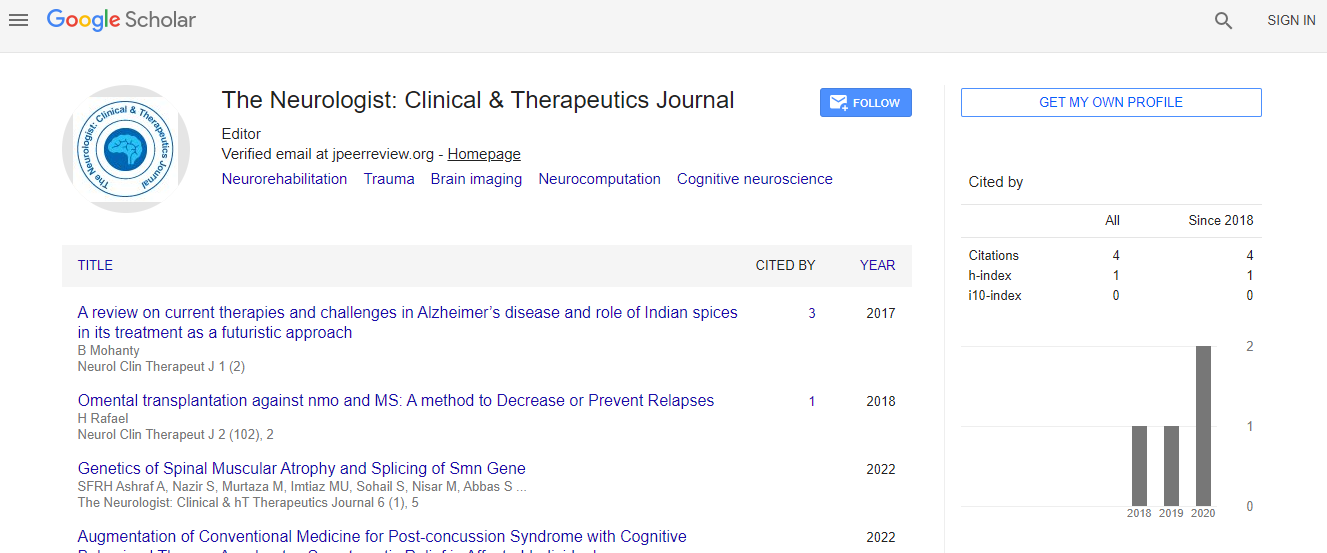Neurosurgery 2020: Clinical Implementations of Neuromodulation: rTMS For the Treatment of Depression - M. Sonsati - The Oaktree Clinic
*Corresponding Author:
Copyright: © 2020 . This is an open-access article distributed under the terms of the Creative Commons Attribution License, which permits unrestricted use, distribution, and reproduction in any medium, provided the original author and source are credited.
Abstract
Repetitive Transcranial Magnetic Stimulation (rTMS) is becoming an increasingly popular treatment for individuals suffering with severe clinical depression. rTMS uses a magnetic field to alter the electrical signals within the brain. The evidence suggests that individuals with depression show a decreased activity within the dorsolateral prefrontal cortex (DLPFC). High frequency stimulation of this region has shown to significantly reduce depressive symptoms whilst having the benefit of a non-invasive & generally side effect free treatment. We have conducted an internal audit of rTMS patients experiencing depressive symptoms; collating the overall effect of the treatment.
Based on the principle of electromagnetic induction, TMS modulates the brain’s electrical environment using magnetic fields, which pass through the scalp & skull unimpeded. These fields are produced by passing rapidly alternating electrical currents through a coil with a ferromagnetic core (ie, an electromagnet in lieu of a permanent magnet). The magnetic field strength produced by TMS varies from 1.5 to 3 T & is comparable to an MRI device, except that it focuses on a limited area of the cortex using a circular, figure-eight, conical, or helmet-like coil design (eg, H-coil). TMS can be administered in single pulses or as a brief series of pulses, called a train, for research, diagnostic, & therapeutic purposes. When used clinically, several thous& pulses are usually applied over a period of minutes to hours. This is called repetitive transcranial magnetic stimulation or “rTMS”. These pulses can be delivered in a rapid (ie, >1–20 Hz) repetitive fashion, enhancing cortical activity; or in a slow (ie, <1 Hz) repetitive fashion, inhibiting cortical activity. For this review, we will use the term TMS.
TMS is an advanced treatment modality for patients with TRD, in which brief magnetic pulses are applied to the brain, leading to cortical stimulation. Repetitive TMS (rTMS) consists of the delivery of pulses in a repetitive fashion. TMS is a non-invasive technique, as it does not require craniotomy or seizure induction to stimulate nerve cells. Rather, TMS interconverts electrical & magnetic energy to induce electromagnetic phenomena. An electromagnetic coil is placed on the scalp, & an effective pulsatile magnetic field that depolarizes cortical neurons is generated for a brief duration of time. This forceful magnetic field is generated on the surface of the scalp, without any intrusion into the skin, muscles or bones, making its electrical stimulation electrodeless. Levels of excitability of neuronal stimulation can be regulated, either by high (10 to 20 Hz) or low (1 Hz) frequency. The generated magnetic field is about 1.5 Tesla, similar in strength to that of magnetic resonance imaging. Patients being treated with TMS undergo five daily treatment sessions over three to six weeks, resulting in a total of 20 to 30 sessions during treatment.
In summary, TMS is a promising, novel antidepressant treatment still relatively early in its development. Its efficacy & safety have improved significantly with continued research & clinical experience. The effect size for TMS antidepressant efficacy is at least comparable to those of antidepressant medications even though studies included only treatment-resistant or treatment-intolerant depressed patients. To date, this evidence base satisfies the critical thresholds for FDA clearance & approval of coverage by most third-party payers in health care. Further, there is a signal that TMS may benefit certain subgroups of patients who previously would be referred for ECT. Finally, the durability of TMS’ antidepressant benefit & safety & tolerability profile make it an attractive treatment option for selected patients. Although TMS is labor intensive compared with medications, its efficacy, safety, & tolerability for depression & possibly other disorders are driving additional research to refine & improve its therapeutic potential.
In addition to investigating biological markers of TMS response as mentioned earlier, there are several ongoing projects to further refine the application of TMS to achieve therapeutic enhancement. TMS is regarded as an effective & safe stimulation technique. However, it has a few side effects that might affect treatment compliance. Commonly reported adverse effects include transitory &/or recurrent headaches that respond to over the counter analgesics, a tingling sensation on the scalp & face, & ipsilateral lacrimation. Seizure activity is rare, & one patient was reported to develop trigeminal autonomic cephalalgia after the administration of rTMS for refractory depression.
Analysis of data included 4 time points which did not meet statistical parametric assumptions. This warranted the use of using Spearman’s rho for looking at correlations between week 1 & week 4. The correlation between week 1 & week 4 was found to be statistically significant. In addition, there was a significant effect found for reductions in BDI scores. The effects of rTMS displayed significant reductions (>50%) in BDI scores attributed to a decrease in depressive symptoms. The research identified the majority of participants transitioned from severe clinical to mild depressive symptoms. rTMS was found to be most effective in adults, rTMS showed strong efficacy for older age adults. There were no significant relationships found between rTMS with ethnic background, number of previous treatments, or clinical depressive classification; with the treatment being equally effective for both genders.

 Spanish
Spanish  Chinese
Chinese  Russian
Russian  German
German  French
French  Japanese
Japanese  Portuguese
Portuguese  Hindi
Hindi 